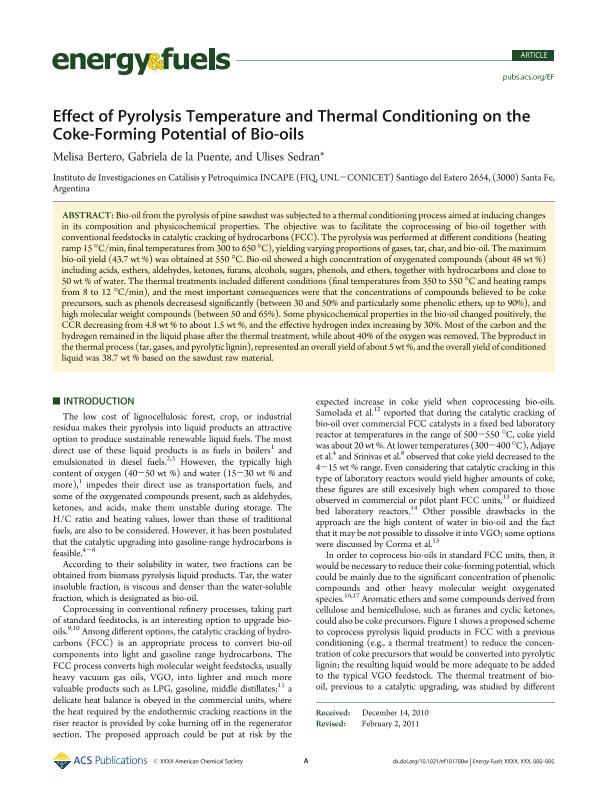Mostrar el registro sencillo del ítem
dc.contributor.author
Melisa Bertero
dc.contributor.author
Gabriela de la Puente
dc.contributor.author
Sedran, Ulises Anselmo

dc.date.available
2018-07-25T12:11:02Z
dc.date.issued
2011-05
dc.identifier.citation
Melisa Bertero; Gabriela de la Puente; Sedran, Ulises Anselmo; Effect of pyrolysis temperature and thermal conditioning on the coke-forming potential of bio-oils; American Chemical Society; Energy & Fuels (print); 25; 3; 5-2011; 1267-1275
dc.identifier.issn
0887-0624
dc.identifier.uri
http://hdl.handle.net/11336/53052
dc.description.abstract
Bio-oil from the pyrolysis of pine sawdust was subjected to a thermal conditioning process aimed at inducing changes in its composition and physicochemical properties. The objective was to facilitate the coprocessing of bio-oil together with conventional feedstocks in catalytic cracking of hydrocarbons (FCC). The pyrolysis was performed at different conditions (heating ramp 15 °C/min, final temperatures from 300 to 650 °C), yielding varying proportions of gases, tar, char, and bio-oil. The maximum bio-oil yield (43.7 wt %) was obtained at 550 °C. Bio-oil showed a high concentration of oxygenated compounds (about 48 wt %) including acids, esthers, aldehydes, ketones, furans, alcohols, sugars, phenols, and ethers, together with hydrocarbons and close to 50 wt % of water. The thermal treatments included different conditions (final temperatures from 350 to 550 °C and heating ramps from 8 to 12 °C/min), and the most important consequences were that the concentrations of compounds believed to be coke precursors, such as phenols decreasesd significantly (between 30 and 50% and particularly some phenolic ethers, up to 90%), and high molecular weight compounds (between 50 and 65%). Some physicochemical properties in the bio-oil changed positively, the CCR decreasing from 4.8 wt % to about 1.5 wt %, and the effective hydrogen index increasing by 30%. Most of the carbon and the hydrogen remained in the liquid phase after the thermal treatment, while about 40% of the oxygen was removed. The byproduct in the thermal process (tar, gases, and pyrolytic lignin), represented an overall yield of about 5 wt %, and the overall yield of conditioned liquid was 38.7 wt % based on the sawdust raw material.
dc.format
application/pdf
dc.language.iso
eng
dc.publisher
American Chemical Society

dc.rights
info:eu-repo/semantics/openAccess
dc.rights.uri
https://creativecommons.org/licenses/by-nc-sa/2.5/ar/
dc.subject
Bio-Oil
dc.subject
Co-Processing
dc.subject
Thermal Conditioning
dc.subject
Fcc
dc.subject.classification
Otras Ingeniería Química

dc.subject.classification
Ingeniería Química

dc.subject.classification
INGENIERÍAS Y TECNOLOGÍAS

dc.title
Effect of pyrolysis temperature and thermal conditioning on the coke-forming potential of bio-oils
dc.type
info:eu-repo/semantics/article
dc.type
info:ar-repo/semantics/artículo
dc.type
info:eu-repo/semantics/publishedVersion
dc.date.updated
2018-07-20T14:18:25Z
dc.journal.volume
25
dc.journal.number
3
dc.journal.pagination
1267-1275
dc.journal.pais
Estados Unidos

dc.journal.ciudad
Washington
dc.description.fil
Fil: Melisa Bertero. Consejo Nacional de Investigaciones Científicas y Técnicas. Centro Científico Tecnológico Conicet - Santa Fe. Instituto de Investigaciones en Catálisis y Petroquímica ; Argentina
dc.description.fil
Fil: Gabriela de la Puente. Consejo Nacional de Investigaciones Científicas y Técnicas. Centro Científico Tecnológico Conicet - Santa Fe. Instituto de Investigaciones en Catálisis y Petroquímica ; Argentina
dc.description.fil
Fil: Sedran, Ulises Anselmo. Consejo Nacional de Investigaciones Científicas y Técnicas. Centro Científico Tecnológico Conicet - Santa Fe. Instituto de Investigaciones en Catálisis y Petroquímica ; Argentina
dc.journal.title
Energy & Fuels (print)

dc.relation.alternativeid
info:eu-repo/semantics/altIdentifier/doi/http://dx.doi.org/10.1021/ef101700w
Archivos asociados
